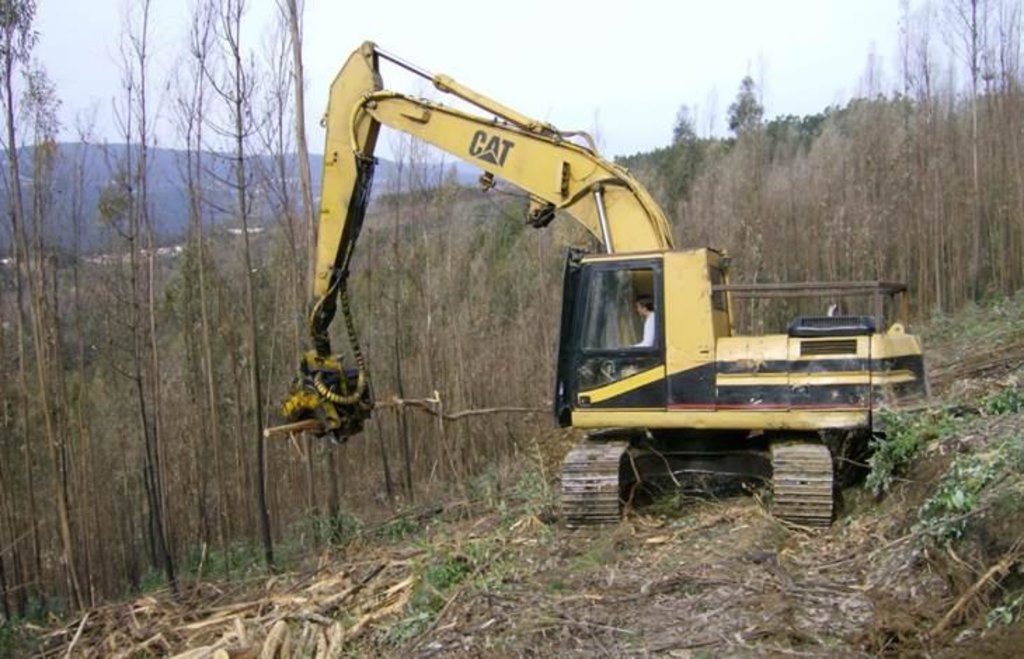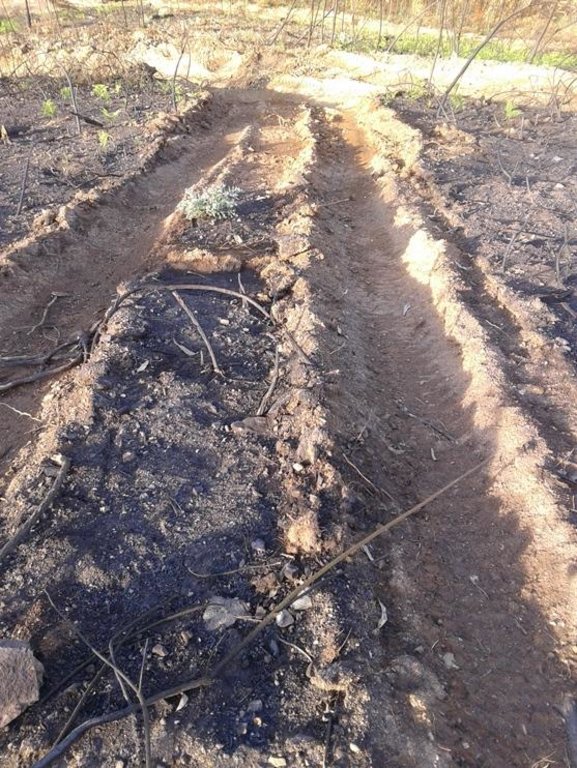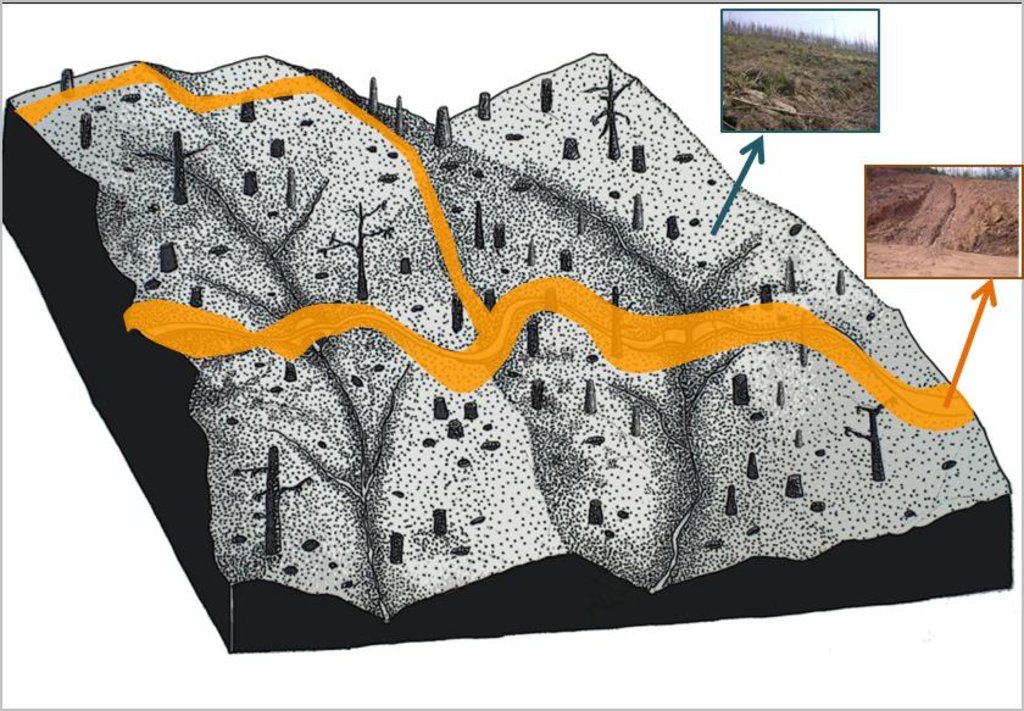Post-fire salvage logging; post-fire traditional logging [葡萄牙]
- 创建:
- 更新:
- 编制者: Maruxa Malvar Cortizo
- 编辑者: –
- 审查者: Fabian Ottiger
Extração material lenhoso pos-incêndio
technologies_1713 - 葡萄牙
查看章节
全部展开 全部收起1. 一般信息
1.2 参与该技术评估和文件编制的资源人员和机构的联系方式
SLM专业人员:
SLM专业人员:
SLM专业人员:
Keizer Jan Jacob
+ 351 234 370200
jjkeizer@ua.pt.
Centre for Environmental and Marine Studies (CESAM) - Department of Environment and Planning-University of Aveiro
Campus de Santiago, 3810-193 Aveiro, Portugal
葡萄牙
有助于对技术进行记录/评估的机构名称(如相关)
University of Aveiro (University of Aveiro) - 葡萄牙1.3 关于使用通过WOCAT记录的数据的条件
(现场)数据是什么时候汇编的?:
21/09/2016
编制者和关键资源人员接受有关使用通过WOCAT记录数据的条件。:
是
2. SLM技术的说明
2.1 技术简介
技术定义:
Post-fire salvage logging is the practice of harvest the trees after fire, the employed methodology is clearcutting which involves the cut of essentially all the trees and the removal of logging residues.
2.2 技术的详细说明
说明:
In the 2015 summer a wildfire affected the Semide mountain range nearby the Lousã massif, central Portugal. The area was afforested with eucalypt and pine plantations during last XX century and nowadays landscape is composed mainly by eucalypts at different stages of development and, the understory shrub vegetation.
The research team of the University of Aveiro set up an experiment to test the effect of post-fire logging in soil erosion and other selected soil properties.
Purpose of the Technology: Post-fire logging is a common management practice usually undertaken to recover burnt timber resources, to plant new seedlings and to reduce possible insect infestation hazard. In Portugal, about 10x106 m3 of timber could be harvested every year and a considerable percentage of this figure comes from recently burned eucalypt and pine stands.
Post-fire logging could have a multiple detrimental effect on ecosystem as fire-affected ecosystems are sensitive to further disturbance. This multiplier effect concerns soil compaction, soil (fertility) losses, with serious implications for in-situ plant growth, soil biota and for downstream aquatic systems. Furthermore, post-fire logging undermines the effectiveness of costly rehabilitation efforts aimed at reducing soil erosion. Hence, the post-fire logging practice is still controversial in terms of economic benefit and environmental consequences, in many parts of the world.
Establishment / maintenance activities and inputs: The standard logging technique consists of felling burned trees either with a harvester or manually with a chainsaw depending on slope conditions and machinery available. The logs will be gathered with the harvester, using a cable-skidder or pulling logs down-slope with a cable attached to a tractor. A forwarder will transport them to the main pile prior to load and removal by trucks.
The slope will present two well differenced units according to soil surface disturbance, the skid trail or the logged area.
Natural / human environment: The eucalypt trees in the region are typically planted as monocultures for paper pulp production, and harvested every 7-14 years. The landscape reflects a long history of intense land management, with a mosaic of (semi-)natural and man-made agricultural and afforested lands. Since the 1980´s, however, wildfires have increased dramatically in frequency and extent, aided by a general warming and drying trend but driven primarily by socio-economic changes.
2.3 技术照片
2.5 已应用该技术的、本评估所涵盖的国家/地区/地点
国家:
葡萄牙
区域/州/省:
Coimbra
有关地点的进一步说明:
Coimbra
2.6 实施日期
如果不知道确切的年份,请说明大概的日期:
- 50多年前(传统)
2.7 技术介绍
详细说明该技术是如何引入的:
- 作为传统系统的一部分(> 50 年)
3. SLM技术的分类
3.2 应用该技术的当前土地利用类型

森林/林地
产品和服务:
- 木材
- 薪材
注释:
Major land use problems (compiler’s opinion): Strong increases in runoff and erosion should be a main land management concern following wildfires, as they constitute a serious threat to land-use sustainability and downstream aquatic habitats and human infrastructures. In addition to fire itself, post-fire logging activities can greatly increase erosion response of recently burnt areas. Furthermore, logging is typically the most common practice after fire, and recently burnt soils are more erodible than long-unburnt soils.
Major land use problems (land users’ perception): Loss of wood resources and productivity.
Plantation forestry: Yes
Forest products and services: timber, fuelwood
3.3 有关土地利用的更多信息
每年的生长季节数:
- 3
具体说明:
Longest growing period in days: 270Longest growing period from month to month: September to May
3.4 该技术所属的SLM组
- 天然和半天然森林管理
- 森林种植管理
- Post-fire logging
3.5 技术传播
具体说明该技术的分布:
- 均匀地分布在一个区域
如果该技术均匀地分布在一个区域上,请注明覆盖的大致区域。:
- < 0.1 平方千米(10 公顷)
注释:
The studied area is a hillslope scale but total logged area is larger
3.6 包含该技术的可持续土地管理措施

农艺措施
- A1:植被和土壤覆盖层

植物措施
- V3:植被的清理

管理措施
- M7:其它
注释:
Main measures: management measures
Specification of other management measures: Recover burnt timber resources and improve the re-sprout of new eucalypts
3.7 该技术强调的主要土地退化类型

土壤水蚀
- Wt:表土流失/地表侵蚀

物理性土壤退化
- Pc:压实

生物性退化
- Bc:植被覆盖的减少
- Bf:火灾的有害影响
注释:
Main type of degradation addressed: Wt: loss of topsoil / surface erosion, Pc: compaction, Bc: reduction of vegetation cover, Bf: detrimental effects of fires
Main causes of degradation: soil management (Eucalypt plantations are prone to forest fires), crop management (annual, perennial, tree/shrub) (Logging increases soil erosin risk and soil compactation), deforestation / removal of natural vegetation (incl. forest fires) (Logging increases the lost of vegetation cover), population pressure (Since the 1980´s, eucalypt plantations increased greatly, driven primarily by socio-economic changes.)
3.8 防止、减少或恢复土地退化
具体数量名该技术与土地退化有关的目标:
- 减少土地退化
注释:
Secondary goals: mitigation / reduction of land degradation
4. 技术规范、实施活动、投入和成本
4.1 该技术的技术图纸
4.2 技术规范/技术图纸说明
The slope will present two well differentiated units according to soil surface disturbance, the machinery trail and the logged area. The soil erosion risk will be associated with the loss of ground cover due to mechanical disturbance. Furthermore, the machinery trail presents the risk of concentrated overland-flow with the subsequent rill formation.
Location: Semide. Coimbra
Technical knowledge required for field staff / advisors: low
Technical knowledge required for land users: low (The use of machinery is preferable but not essential)
Main technical functions: control of dispersed runoff: retain / trap, control of concentrated runoff: impede / retard, improvement of ground cover, improvement of surface structure (crusting, sealing), sediment retention / trapping, sediment harvesting
Secondary technical functions: control of raindrop splash, improvement of subsoil structure (hardpan)
Other type of management: Recover burnt timber resources and improve the re-sprout of eucalypt stumps
4.3 有关投入和成本计算的一般信息
其它/国家货币(具体说明):
euros
注明美元与当地货币的汇率(如相关):1美元=:
0.92
注明雇用劳工的每日平均工资成本:
60.87
4.4 技术建立活动
| 活动 | 措施类型 | 时间 | |
|---|---|---|---|
| 1. | 1 person with chainsaw | 管理 | 24 |
| 2. | Harvester transport ( in a radio of 50 km)Harvester working (with person)Forwarder (with person)Final transport (in a radio of 50 km) | 管理 | 60 |
4.5 技术建立所需要的费用和投入
| 对投入进行具体说明 | 单位 | 数量 | 单位成本 | 每项投入的总成本 | 土地使用者承担的成本% | |
|---|---|---|---|---|---|---|
| 劳动力 | Labour | ha | 1.0 | 1461.0 | 1461.0 | |
| 设备 | Machine use | ha | 1.0 | 5870.0 | 5870.0 | |
| 技术建立所需总成本 | 7331.0 | |||||
4.7 维护/经常性活动所需要的费用和投入(每年)
注释:
The prices were determined for a clearcutting of a slope with acceptable slope degree and accessibility. Prices were calculated by hectare in winter 2015 for central Portugal.
4.8 影响成本的最重要因素
描述影响成本的最决定性因素:
Accessibility and steepness will raise the costs. The use of machinery is not a mandatory. Small land owners decrease the total cost by doing manual work with a family framework.
5. 自然和人文环境
5.1 气候
年降雨量
- < 250毫米
- 251-500毫米
- 501-750毫米
- 751-1,000毫米
- 1,001-1,500毫米
- 1,501-2,000毫米
- 2,001-3,000毫米
- 3,001-4,000毫米
- > 4,000毫米
农业气候带
- 潮湿的
- 半湿润
Thermal climate class: subtropics
Thermal climate class: temperate
5.2 地形
平均坡度:
- 水平(0-2%)
- 缓降(3-5%)
- 平缓(6-10%)
- 滚坡(11-15%)
- 崎岖(16-30%)
- 陡峭(31-60%)
- 非常陡峭(>60%)
地形:
- 高原/平原
- 山脊
- 山坡
- 山地斜坡
- 麓坡
- 谷底
垂直分布带:
- 0-100 m a.s.l.
- 101-500 m a.s.l.
- 501-1,000 m a.s.l.
- 1,001-1,500 m a.s.l.
- 1,501-2,000 m a.s.l.
- 2,001-2,500 m a.s.l.
- 2,501-3,000 m a.s.l.
- 3,001-4,000 m a.s.l.
- > 4,000 m a.s.l.
5.3 土壤
平均土层深度:
- 非常浅(0-20厘米)
- 浅(21-50厘米)
- 中等深度(51-80厘米)
- 深(81-120厘米)
- 非常深(> 120厘米)
土壤质地(表土):
- 粗粒/轻(砂质)
- 中粒(壤土、粉土)
表土有机质:
- 高(>3%)
如有可能,附上完整的土壤描述或具体说明可用的信息,例如土壤类型、土壤酸碱度、阳离子交换能力、氮、盐度等。:
Soil fertility is medium-high
Topsoil organic matter is high (afforested soils)
Soil drainage/infiltration is poor-medium ( Soil water repellency)
Soil water storage capacity is low (very shallow soils)
5.4 水资源可用性和质量
地下水位表:
5-50米
地表水的可用性:
好
水质(未处理):
良好饮用水
关于水质和水量的注释和进一步规范:
Availability of surface water is good - medium (very dry summer)
5.5 生物多样性
物种多样性:
- 低
关于生物多样性的注释和进一步规范:
Burnt soil
5.6 应用该技术的土地使用者的特征
生产系统的市场定位:
- 混合(生计/商业
- 商业/市场
非农收入:
- 收入的10-50%
相对财富水平:
- 贫瘠
- 平均水平
个人或集体:
- 个人/家庭
性别:
- 男人
说明土地使用者的其他有关特征:
Land users applying the Technology are mainly common / average land users
Difference in the involvement of women and men: Harvesting forest areas is typically a men work, probably due to the machinery use and/or the physical strength needed.
Population density: 50-100 persons/km2
Annual population growth: < 0.5%
Market orientation of production system: subsistence (self-supply), mixed (subsistence/ commercial, commercial/ market
5.7 应用该技术的土地使用者拥有或租用的平均土地面积
- < 0.5 公顷
- 0.5-1 公顷
- 1-2 公顷
- 2-5公顷
- 5-15公顷
- 15-50公顷
- 50-100公顷
- 100-500公顷
- 500-1,000公顷
- 1,000-10,000公顷
- > 10,000公顷
这被认为是小规模、中规模还是大规模的(参照当地实际情况)?:
- 小规模的
注释:
Average area of land owned or leased by land users applying the Technology: 2-5 ha, 5-15 ha, 15-50 ha
5.8 土地所有权、土地使用权和水使用权
土地所有权:
- 个人,未命名
用水权:
- 社区(有组织)
5.9 进入服务和基础设施的通道
健康:
- 贫瘠
- 适度的
- 好
教育:
- 贫瘠
- 适度的
- 好
技术援助:
- 贫瘠
- 适度的
- 好
就业(例如非农):
- 贫瘠
- 适度的
- 好
市场:
- 贫瘠
- 适度的
- 好
能源:
- 贫瘠
- 适度的
- 好
道路和交通:
- 贫瘠
- 适度的
- 好
饮用水和卫生设施:
- 贫瘠
- 适度的
- 好
金融服务:
- 贫瘠
- 适度的
- 好
6. 影响和结论性说明
6.1 该技术的现场影响
社会经济效应
生产
木材生产
产品多样性
注释/具体说明:
Promoves eucalypt monocultures
能源生产
注释/具体说明:
Biomass
收入和成本
收入来源的多样性
社会文化影响
娱乐机会
注释/具体说明:
The logging of the burnt trunks arguably improves the esthetic value of the area, including by removing evidence of the fire
Improved livelihoods and human well-being
注释/具体说明:
Yes, because timber production is a complementary income for many families in the region
生态影响
水循环/径流
水质
地表径流
蒸发
土壤
土壤水分
土壤覆盖层
土壤结壳/密封
土壤压实
土壤有机物/地下C
生物多样性:植被、动物
害虫/疾病控制
减少气候和灾害风险
火灾风险
风速
其它生态影响
Soil erosion locally
Crop diversity
Habitat fragmentation
6.2 该技术的场外影响已经显现
旱季稳定可靠的水流
下游洪水
下游淤积
地下水/河流污染
缓冲/过滤能力
对邻近农田的破坏
对公共/私人基础设施的破坏
6.3 技术对渐变气候以及与气候相关的极端情况/灾害的暴露和敏感性(土地使用者认为的极端情况/灾害)
渐变气候
渐变气候
| 季节 | 气候变化/极端天气的类型 | 该技术是如何应对的? | |
|---|---|---|---|
| 年温度 | 增加 | 好 |
气候有关的极端情况(灾害)
气象灾害
| 该技术是如何应对的? | |
|---|---|
| 局地暴雨 | 不好 |
| 局地风暴 | 好 |
气候灾害
| 该技术是如何应对的? | |
|---|---|
| 干旱 | 不好 |
水文灾害
| 该技术是如何应对的? | |
|---|---|
| 比较和缓的(河道)洪水 | 好 |
其他气候相关的后果
其他气候相关的后果
| 该技术是如何应对的? | |
|---|---|
| 缩短生长期 | 不好 |
6.4 成本效益分析
技术收益与技术建立成本相比如何(从土地使用者的角度看)?
短期回报:
稍微积极
长期回报:
积极
注释:
There is no maintenance
6.5 技术采用
注释:
100% of land user families have adopted the Technology without any external material support
Comments on spontaneous adoption: Small land owners need to request the clearcutting to harvester companies; but they do it spontaneus
6.7 该技术的优点/长处/机会
| 土地使用者眼中的长处/优势/机会 |
|---|
|
Short-term economic benefits How can they be sustained / enhanced? Decrease wildfires will increase the economic value of the timber |
| 编制者或其他关键资源人员认为的长处/优势/机会 |
|---|
|
The chance to obtain an economic benefit from forest plantations diminished depopulation of rural areas in the region. How can they be sustained / enhanced? A diversification toward native forest species cultivation (i.e. cork oak, olive trees, and chestnut tree) would be a very good alternative for the improvement of the ecosystem services, the reduction of wildfires risk and the increase of the socio-economic conditions in the region |
6.8 技术的弱点/缺点/风险及其克服方法
| 土地使用者认为的弱点/缺点/风险 | 如何克服它们? |
|---|---|
| When timber quality is no good (due to fire) there is no economic benefit | Take the advantage to modify eucalypt plantations toward more sustainable land use |
| 编制者或其他关键资源人员认为的弱点/缺点/风险 | 如何克服它们? |
|---|---|
| Increased runoff and soil erosion and possibly modify soil properties | There are several mitigation treatments that can be used to decrease the risk of soil erosion/degradation after logging activities. The use of water dams in the machinery trails and/or the spread of logging residues on the uncover/disturbed soil are techniques that can give good results |
7. 参考和链接
7.2 参考可用出版物
标题、作者、年份、ISBN:
DellaSala, D.A., 2006. Post-fire Logging, Summary of Key Studies and Findings. World Wildlife Fund, Washington,USA.
http://www.nccsp.org/files/Postfire%20Summary%20of%20Key%20Findings.pdf
Fernández. C, J.A. Vega, Fonturbel.T Pérez-Gorostiaga P., Jiménez E., Madrigal.J., 2007. Effects of wildfire salvage logging and slash treatments on soil degradation. Land Degrad. Develop. 18: 591–607. DOI: 10.1002/ldr.797.
Inbar, M., Wittenberg, L., Tamir, M., 1997. Soil erosion and forestry management after wildfire in a Mediterranean woodland, Mt. Carmel, Israel. International Journal of Wildland Fire 7: 285–294.
Malvar, M.C., Martins, M.A.S., Nunes, J.P., Robichaud, P.R., Keizer, J.J., 2013. Assessing the role of pre-fire ground preparation operations and soil water repellency in post-fire runoff and inter-rill erosion by repeated rainfall simulation experiments in Portuguese eucalypt plantations. Catena, 108, 69-83.
Prats S.A., Malvar M.C., Vieira D.C.S., Keizer J.J., 2013, in press. Effectiveness of hydromulching to reduce runoff and erosion in a recently burnt and logged Maritime Pine stand in central Portugal. Land Degradation and Development. (accepted in June 2013).DOI: 10.1002/ldr.2236.
RECARE project: Preventing and Remediating degradation of soils in Europe trhough Land Care.
http://www.recare-project.eu/
可以从哪里获得?成本如何?
internet
链接和模块
全部展开 全部收起链接
无链接
模块
无模块





